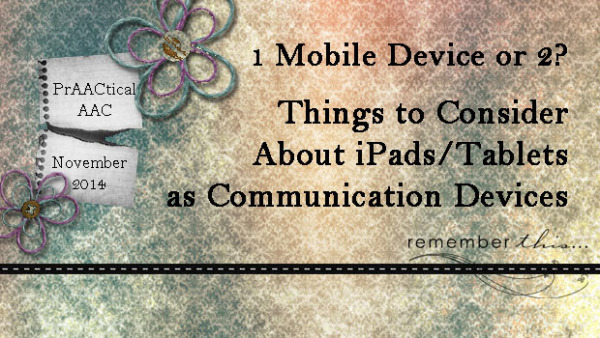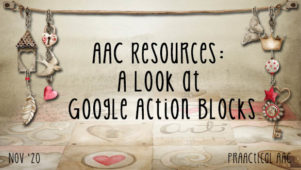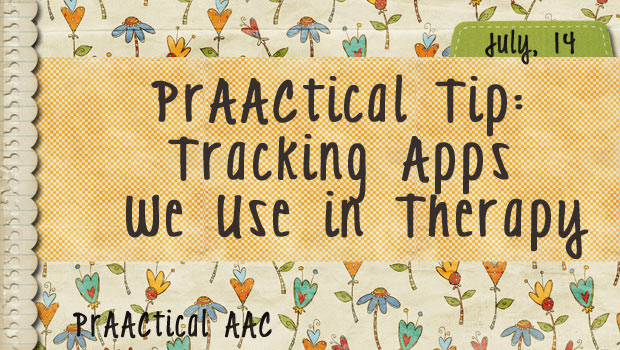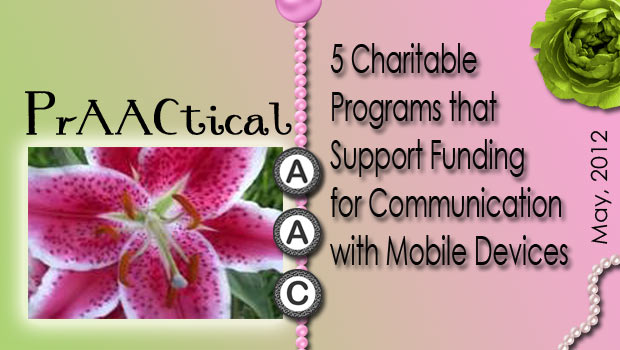One Mobile Device or Two? Things to Consider About iPads/Tablets as Communication Devices

Should iPads and tablets be used both for communication and other things? That’s a question we hear rather frequently these days. Our answer will probably frustrate you. Ready? Here goes: It depends.
It depends on the learner. Consider these two students.
Tia is 6 and very much a beginning communicator. She has had her mobile device with a core language based AAC app for a few months. Tia uses it independently to ask for a few of her favorite things, like music and bubbles. With prompting she can use it to ask for a wider variety things, and can also use it for commenting, labeling, greeting, and answering ‘what’ questions. She does not yet combine two symbols to make short sentences.
Yvette is 15 and has been using AAC since she was a toddler. She uses a text-to-speech app on her mobile device and knows how to program phrases and sentences to speed up communication. Yvette spends a lot of time on Facebook but doesn’t let that interfere with her schoolwork. She got mostly B’s in her high school classes last term and surprised her English teacher by turning in an essay that was longer than any other student’s work.
Clearly, Tia and Yvette are different with different needs. A one-size-fits-all approach won’t work.
With kids like Tia, it is a common practice to have the mobile device dedicated to AAC, locking out other apps. Having a mobile device that is dedicated to communication helps the child see it as a tool for expression, which is why they got in in the first place. This often makes sense for beginning AAC users. For them, we generally recommend that beginning AAC users use their mobile device only for communication and have access to second one for learning apps and games. Often what happens is that if there are other apps that they can get to, we run into two problems.
One is that they can’t communicate while they are playing with the educational or fun apps. That is a shame because those are GREAT times for communication learning. We need kids to be able to learn/play and communicate at the same time. Having one device for communication and the other for entertainment/learning helps make that happen.
The bigger problem is that, over time, the learner may prefer the educational apps or games to communicating. Then, when we direct them to the communication app, they resist because they would rather be entertained than talk to us. It creates a power struggle and a barrier to communication development in some cases.
Students like Yvette, on the other hand, are probably perfectly able to transition between multiple uses of the device without difficulty. In these cases, it makes plenty of sense to use one mobile device for communication, note-taking, social media, and entertainment. It’s more convenient and efficient for Yvette
Everyone is different so it stands to reason that one approach won’t fit all situations. Have you encountered this situation? We’d love to hear about your experiences.
Filed under: PrAACtical Thinking
Tagged With: mobile devices, tablets
This post was written by Carole Zangari




11 Comments
Hello. Yes we encounter this all the time with our members who have Down syndrome. Schools or homes often use games on IPADS for incentives and we are teaching communication on the IPAD (touch chat) because that’s what both school and parent have access to unless they get an assessment done that comes back to state the student needs a dedicated talker. We find that most young children do associate an IPAD with fun or taking photos etc so it can be challenging as some get fixated on applications. In those cases we do recommend 2. One for play and one for communication using Guided Access so it is dedicated. We use different color cases to distinguish. It still can be a bit of a struggle. We are very fortunate to have a lending library where parents and teachers can try different devices from go talk to ver expensive dedicated devices thanks to a grant we reviewed from the California Communication Access Foundation. This helps to prove that the student may warrant a dedicated device when they see the benefits before purchasing or in some cases waiting for an assessment which out here can take months or we have seen years due to lack of school district personnel. We believe parents and schools cannot wait to introduce a communication system as we have proven over and over that communication is the key to learning, participation, successful inclusion and much more. Behavior is communication so the sooner we provide an outlet for expression the sooner frustration can subside and it does. We also find that people with Down syndrome are underestimated because of the inability to communicate and that they typically have a higher receptive language than expressive. So any form of opening up communication is a true gift. a THANK YOU for all you do. I am a BIG BIG fan of your work and follow your postings. You knowledge has been invaluable to us in California. :-).
Thanks for that detailed comment, Nancy. It is always helpful to hear how people in various parts of the country are dealing with these issues. I am hoping to get to NorCal in the spring. Maybe we can connect. 🙂
Yes! This is an issue we wrestle with regularly. The kids in the middle are extra tough. We have many elementary & middle school students who need communication/language supports and also need supported academic access or output. If assistive technology suggests an iPad with external keyboard and Notability for curriculum support, can we expect the student to toggle back and forth to their AAC program? Sometimes. Can we expect the student (and staff) to carry, maintain, and implement two devices? Sometimes. Some teams ‘get it’ and buy in to a dedicated AAC model. Others refuse to use two systems. It’s a messy topic for sure!
Another solution we explore is helping families seek private purchase through their insurance. That device is dedicated to communication and it often simplifies this school discussion. Well… sometimes. 🙂
Rachael, I’ve seen exactly the same thing. Good for you guys for partnering with parents in this way. Of course we have to be able to serve all students, but for those who have good insurance and are on board with this, it can be a win-win situation. Thanks for your comment!
I am trying to find the best wasy to get Proloquo2Go for my student at home. We currently use it at school and his iPad is solely used for communication. However, if I can somehow get his outside speech therapist to put something through insurance to get the program approved, then he will be able to get his communication program at home. However, he has a personal iPad at home and it does have games and additional apps on it. Unfortunately, my district has a low economic population and my families struggle financially. I know for sure, my students mother can not afford an additional iPad. Would it not be beneficial to add this program to his personal iPad if it is the only one he has access to at home? I’m so conflicted, and I feel terrible that he has the ability to communicate at school, and then there is no way for him to communicate at home. What is your best suggestion in this case?
Lauren, you may have a perfect solution in collaborating with his private SLP. My suggestion would be to build that relationship and see if you can work together to do an SGD assessment and get him a device he owns. She can take the lead and submit the funding application and you can help collect trial data with different devices and apps. Not only will that get your student full access to AAC, but will also get everyone on the same page with implementation. Both are needed in order to maximize the outcomes for most AAC learners.
I agree with the point that a one-size fits all approach here is not the way to go. I would love for someone to do research in this area, or to know if someone already has. I know in Australia under the National Disability Insurance Scheme we are likely to see people get pushed towards mainstream devices due to cost even when they are not appropriate, and we only have anecdotal evidence at this stage to back up why this is not the best idea.
I’m currently working on an assignment on this very dilemma & am finding it extremely difficult to locate any research in this area.
So if anyone knows of any, I’d be very grateful 🙂
Hi! Do you know of any research articles supporting this/ outlining the benefits of a dedicated system over a non-dedicated tablet? Thanks!
-Carolyn
Thanks for linking back to our site. How exciting to see the way your little guy is growing and learning! 🙂